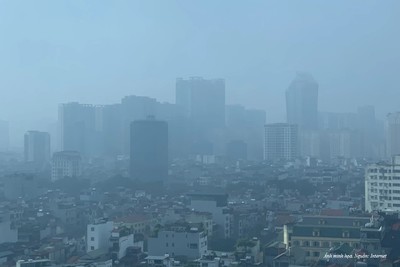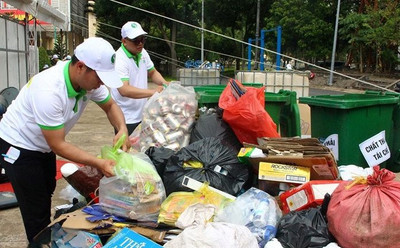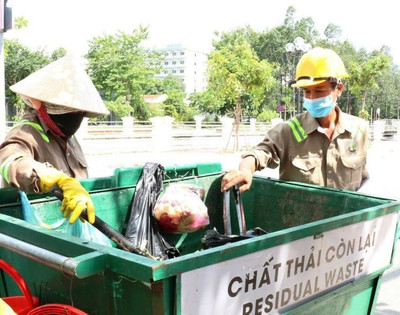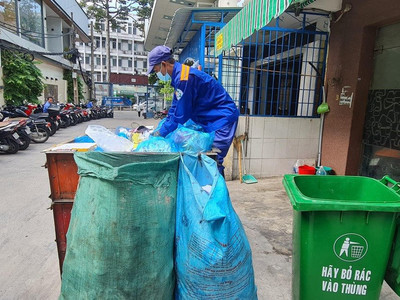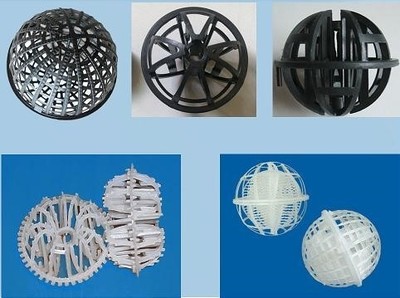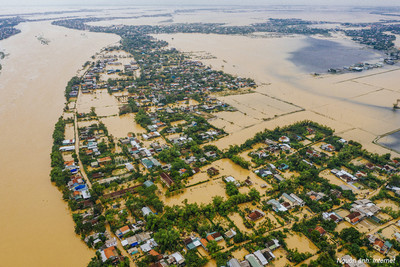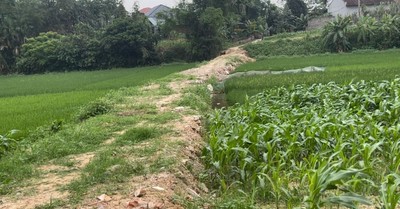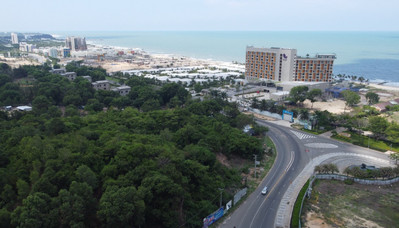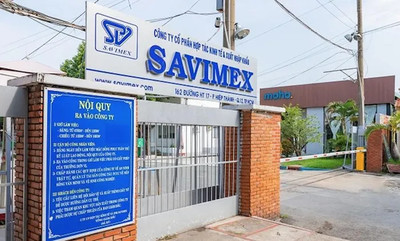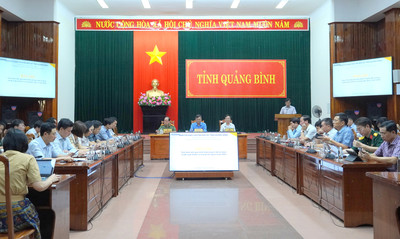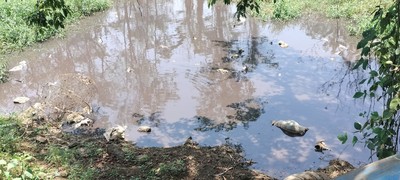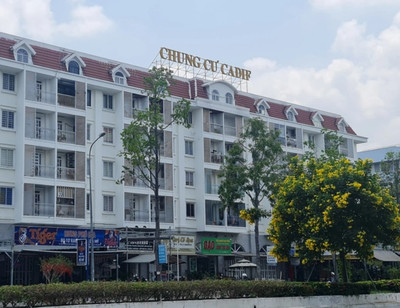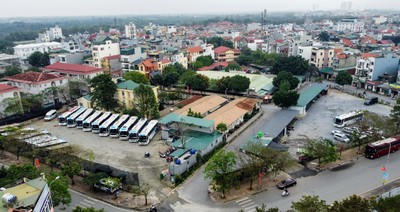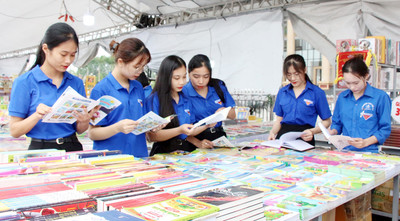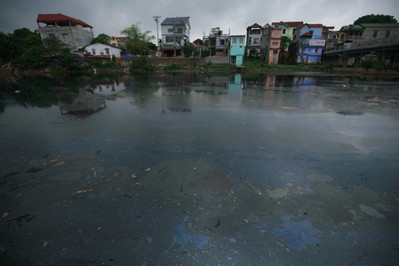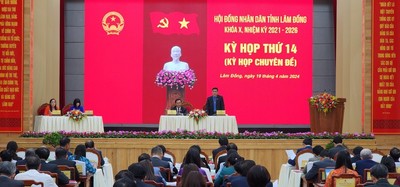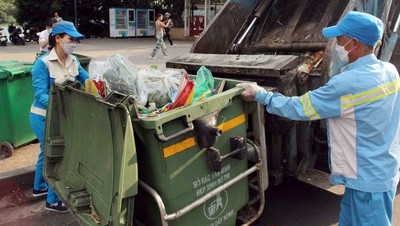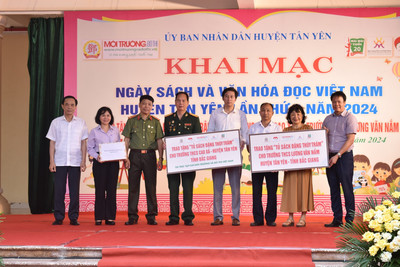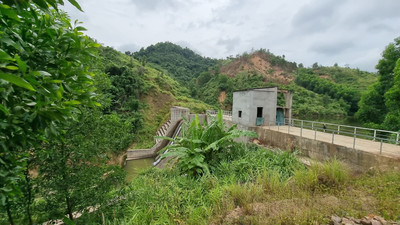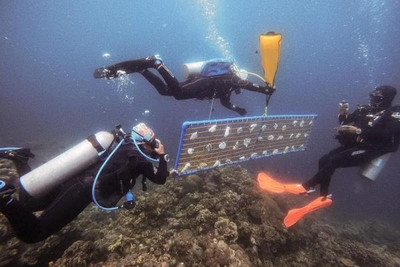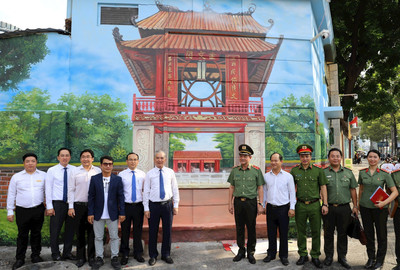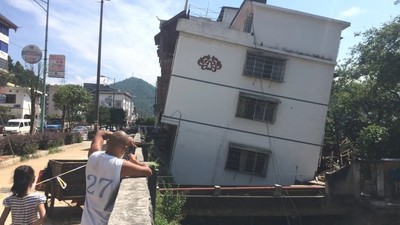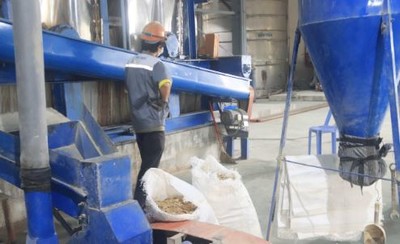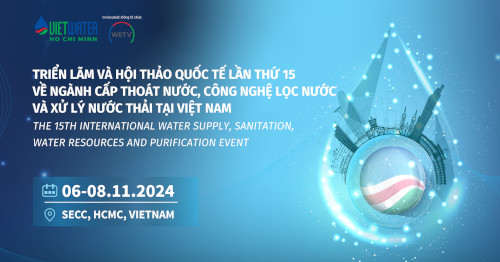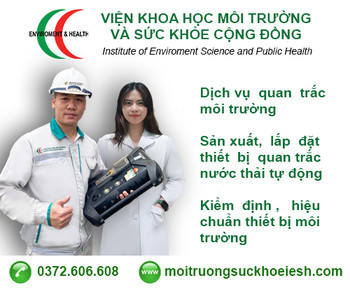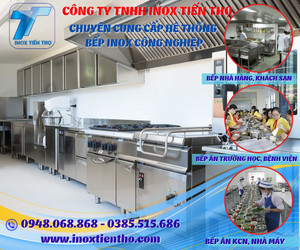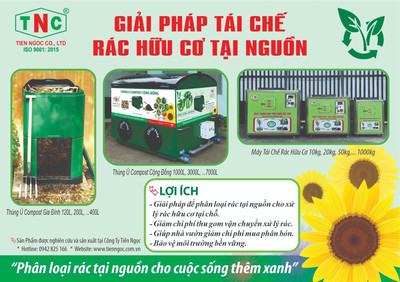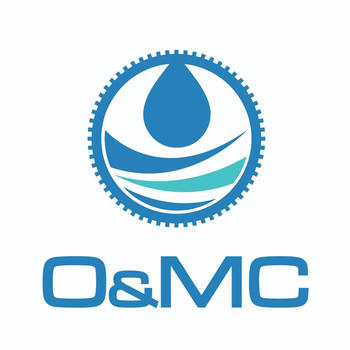Công bố quốc tế lĩnh vực môi trường số 4 năm 2022
Trân trọng giới thiệu với quý bạn đọc công bố quốc tế lĩnh vực môi trường số 4 năm 2022 với những bài nghiên cứu chuyên sâu trong lĩnh vực khoa học môi trường của các nhà báo, nhà nghiên cứu nổi tiếng trên thế giới.
Các công trình khoa học được công bố ở các lĩnh vực quản lý môi trường, môi trường đô thị, môi trường khu công nghiệp, bao quát khắp các hoạt động kinh tế - xã hội, từ sản xuất kinh doanh cho đến sinh hoạt, các khu công nghiệp, làng nghề cho đến sản xuất nông nghiệp, từ thành thị đến nông thôn, ... mỗi nơi đều có nhiều vấn đề đa dạng khác nhau.
Đặc biệt trong đó có công trình nghiên cứu "Xác định các cơ hội để bắt đầu tái chế chất thải: Kinh nghiệm của các nước phát triển điển hình” được đăng trên Tạp chí Journal of Cleaner Production - Số 324, ngày 15/11/2021 của nhóm các nhà khoa học thuộc Phòng thí nghiệm trọng điểm về Tài nguyên nước và Môi trường - Đại học Cát Lâm - Trung Quốc.
Theo các tác giả, tái chế chất thải là một cách hiệu quả để quản lý chất thải hợp lý và điều này phụ thuộc chặt chẽ vào sự hỗ trợ của nền tảng kinh tế xã hội. Những yếu tố nào ảnh hưởng đến việc tái chế chất thải và điều kiện kinh tế xã hội có thể tạo nền tảng cho một quốc gia bắt đầu thực hiện tái chế chất thải vẫn đang được các chuyên gia tiếp tục nghiên cứu. Trong nghiên cứu này, các tác giả đề cập một khung nền tảng kinh tế xã hội bao gồm năm hệ thống nhỏ (Kinh tế, Xã hội, Công nghệ, Thị trường và Ý thức) được xây dựng để tạo điều kiện cho việc tái chế chất thải.
Các nhà nghiên cứu đã phân tích các thành phần chính, cũng như các tác động qua lại giữa các hệ thống nhỏ đó ở 13 quốc gia phát triển được công nhận là có hiệu quả cao trong việc tái chế chất thải.
Kết quả chỉ ra rằng trình độ xã hội, trình độ công nghệ và trình độ ý thức đều thúc đẩy tích cực việc tái chế chất thải, trong đó trình độ xã hội cho thấy tác động mạnh mẽ nhất. Mức độ thị trường và mức độ kinh tế có ảnh hưởng đối với việc tái chế chất thải. Cụ thể là khi mức độ kinh tế đạt đến một phạm vi nhất định và mức độ phát triển của thị trường vượt quá một "phạm vi nhất định” chính là thời điểm thích hợp để bắt đầu tái chế chất thải.
Thông thường, thời điểm phù hợp với việc tái chế chất thải là lúc tổng sản phẩm quốc nội bình quân đầu người dao động trong khoảng 27.654 đến 40.344 USD; sử dụng tài nguyên tái tạo và chất thải lớn hơn 5,07%; tỷ trọng giá trị gia tăng của ngành công nghiệp cấp 3 lớn hơn 67,54%. Các phát hiện của công trình này cung cấp cho các quốc gia / khu vực khác tham chiếu đến hỗ trợ kinh tế xã hội đầy đủ và các cơ hội thích hợp để bắt đầu thực hiện tái chế chất thải.
Trong số này, Chuyên trang Quản lý môi trường giới thiệu tới quý độc giả những nội dung chính như sau:
Về quản lý môi trường
- Phân tách xu hướng phát thải trên các khu vực thuộc EU và vai trò của các chính sách môi trường.
- Xác định các cơ hội để bắt đầu tái chế chất thải: Kinh nghiệm của các nước phát triển điển hình.
- Luật pháp hạn chế ô nhiễm môi trường nhựa và vi nhựa và ảnh hưởng của chúng đối với sự phơi nhiễm của con người.
- Đánh giá những hiểu biết về vi nhựa biển trong khu vực ASEAN.
- Sản xuất và sử dụng tài nguyên thạch cao khử lưu huỳnh bằng khí thải ở Trung Quốc.
- Kiểm kê phát thải do con người gây ra đối với nhiều chất ô nhiễm không khí và các biến thể về mặt không gian của chúng vào năm 2017 cho tỉnh Sơn Đông, Trung Quốc.
- Tiếp cận máy học tổng quát để ước tính oxy hòa tan ở nhiều quy mô không gian bằng cách sử dụng viễn thám.
- Thông điệp trong chai: Đánh giá nguồn gốc và nguồn gốc của rác bãi biển để giải quyết ô nhiễm môi trường biển.
- Giảm thiểu tiềm năng nóng lên toàn cầu và cường độ khí nhà kính trong đất canh tác với phân xanh làm nguồn nitơ.
- So sánh sự thay đổi theo không gian và thời gian về nồng độ nitrat ven sông từ các lưu vực trên cạn đến biển giữa những năm 1980 và những năm 2000 ở Nhật Bản: Tác động của sự thay đổi nhân khẩu học gần đây.
Về môi trường đô thị
- Nhận thức về sự thoải mái nhiệt của con người tại một địa điểm du lịch đô thị - Một nghiên cứu điển hình của Porto (Bồ Đào Nha).
- Đặc trưng cho các mô hình gián đoạn phục hồi của ô nhiễm không khí đô thị trong quá trình giãn cách COVID-19 ở Trung Quốc.
- Ảnh hưởng của các tầng động của tán cây đối với hiệu suất nhiệt của cây xanh trên mái nhà: Một nghiên cứu điển hình ở Singapore.
- Môi trường nhiệt đô thị và cân bằng năng lượng bề mặt trong mô hình đô thị nén cao tầng 3D: Thí nghiệm ngoài trời được mở rộng.
- Đánh giá vi khuẩn và nấm trong không khí trong các tòa nhà kiểu khác nhau ở Nam Kinh, một thành phố ẩm ướt vào mùa hè nóng nực và mùa đông lạnh giá của Trung Quốc.
- Điều tra các yếu tố ảnh hưởng đến hoạt động của người ở đối với cửa sổ trong các căn hộ được trang bị máy lọc không khí di động.
- Hướng tới một cách tiếp cận thử nghiệm để đo lường việc loại bỏ các chất ô nhiễm không khí đô thị bằng các mái nhà xanh.
- Tác động tổng hợp của đảo nhiệt và ẩm đô thị trong một thành phố nhỏ cao tầng.
- Các chiến lược xử lý hóa lý và sinh học để chuyển đổi nước thải đô thị và chất cặn bã của nó thành tài nguyên.
- Tác động của thời gian và tỷ lệ sử dụng phốt pho đến sinh khả dụng và hiệu quả của phân bón thứ cấp thu hồi từ nước thải đô thị.
- Giám sát nước thải SARS-CoV-2 cấp thành phố.
Về môi trường khu công nghiệp
- Quá trình oxy hóa nước siêu tới hạn của chất thải clo hóa từ bột giấy và nhà máy giấy.
- Thu hồi các chất cao phân tử từ bùn dư thừa: Khai thác siêu âm tăng cường chất hoạt động bề mặt và phân tích tính chất.
- Cải thiện kết quả từ các vùng đất ngập nước được xây dựng bằng điện bằng cách trộn nước thải từ các ngành công nghiệp chế biến đồ uống khác nhau.
- Theo dõi ô nhiễm nguyên tố đất và bụi bởi một nhà máy luyện ferronickel ở New Caledonian: Nguy cơ phát tán, làm giàu và sức khỏe con người.
- Tổng hợp và đánh giá hiệu suất của aerogel thải nhựa như chất hấp thụ dầu bền vững và có thể tái sử dụng.
- Các nguồn PM2.5 và các phản ứng của nó đối với các chiến lược giảm phát thải ở Khu vực Kinh tế Đồng bằng Trung tâm ở Trung Quốc: Hàm ý đối với các tác động của COVID-19.
- Đặc điểm và rủi ro sức khỏe của loạt benzen và halocarbon gần khu công nghiệp hóa chất điển hình.
- Các biến đổi không gian - thời gian được phân giải cao của các chất ô nhiễm không khí từ các lò hơi công nghiệp của Trung Quốc.
- Giám sát dựa trên ảnh hưởng của các hợp chất hoạt tính sinh học liên quan đến việc xả nước thải của nhà máy xử lý nước thải thành phố ra sông South Platte, Colorado, Hoa Kỳ.
Dưới đây, Chuyên trang Quản lý môi trường trân trọng giới thiệu tới bạn đọc phần tóm tắt bằng tiếng Anh của các công trình nghiên cứu.
QUẢN LÝ MÔI TRƯỜNG
1. Decoupling trends of emissions across EU regions and the role of environmental policies
Journal of Cleaner Production, Volume 323, 10 November 2021, 129130
Abstract
The paper combines grid-level data of eight emission types – CO2, N20, CH4, NH3, NOX, PM10, PM2.5, and SO2 – with sub-national economic data to create a 1995–2015 balanced panel for NUTS 2 regions in EU countries. Regions on average show decoupling of emissions from output but most of the emission reductions are achieved before the 2008 financial crisis. Post 2008, very weak decoupling and even coupling can be observed. Using OECD’s Environmental Policy Stringency (EPS) Index as an intervention variable, an event study analysis shows that strong policies significantly reduce emissions, but there is considerable heterogeneity in the response by emission types and regional income levels.
2. Identifying opportunities for initiating waste recycling: Experiences of typical developed countries
Journal of Cleaner Production, Volume 324, 15 November 2021, 129190
Abstract
Waste recycling is an effective way for sound waste management, which depends closely on the support of socioeconomic foundation. Which factors restrict waste recycling, and what level of socioeconomic conditions can potentially underpin a country for initiating waste recycling remain to be explored. In this study, a socioeconomic foundation framework consisting of five subsystems (Economy, Society, Technology, Market and Consciousness) is constructed. Principal component analysis and panel threshold regression model are combined to analyze the impacts and proper numerical ranges of the subsystems for waste recycling in 13 developed countries that are recognized as highly efficient upon waste recycling. The results indicate that social level, technological level and consciousness level all positively promote waste recycling, with social level showing the most intensive impact. Market level and economic level have threshold effect on waste recycling, namely, when economic level is within a certain range and market maturity exceeds a certain level an appropriate opportunity appears for initiating waste recycling. When suitable for waste recycling, typically, gross domestic product per capita ranges within 27,654–40,344 USD; use of renewable resources and wastes is larger than 5.07%; proportion of tertiary industry's value added is larger than 67.54%. The findings of this work provide other countries/regions with reference to adequate socioeconomic support and appropriate opportunities for initiating waste recycling.
3. A combination of finite mixture distribution model with geo-statistical models to study spatial patterns and hazardous areas of heavy metals in cropland soils of the Guanzhong Plain, Northwest China
Chemosphere, Volume 283, November 2021, 131222
Abstract
An extensive cropland soil investigation was conducted to determine the pollution thresholds and hazardous zones of heavy metals (HMs) in the Guanzhong Plain, by using an integrated approach that combines finite mixture distribution model (FMDM) and geo-statistical analysis. FMDM results demonstrated that Pb, Cr, Ni, and Cu were fitted by binary mixture distributions representing the background and moderate pollution distributions, and Zn was fitted by a triple mixture distribution representing the background, moderate and high contamination distributions. The moderate pollution thresholds of Pb, Cr, Ni, Zn and Cu calculated by FMDM were 29.75, 80.15, 38.60, 81.48 and 27.10 mg kg−1, whereas the cutoff value of Zn high contamination was 97.49 mg kg−1. The moderately polluted thresholds of all five HMs were higher than their background values in the study area, and lower than the corresponding national standards. The indicator kriging simulation showed Pb, Cr, Ni, Zn had <0.1%, 2.6%, <0.1%, 2.9% of total areas exceed contamination cutoff values, whereas the hazardous area of Cu was contiguous, and covered 17.3% of the total area. Overall, 17.5% of the total area surpassed the moderate contamination threshold. The pollution hot spots and hazardous zones of soil HMs were located in the southern part of the Guanzhong Plain, where population and industrial activities are centralized, indicating that anthropogenic activities played a critical role in HMs accumulation in high-risk regions. The combination of geo-statistical and FMDM delineate the thresholds and hazardous area for HMs pollution reliably, and facilitate the improvement of soil environmental management.
4. Legislation to limit the environmental plastic and microplastic pollution and their influence on human exposure
Environmental Pollution, Volume 288, 1 November 2021, 117708
Abstract
Plastic pollution is an emerging problem and is a consequence of the post-consumer plastic waste accumulation in the environment coupled to mismanaged waste programmes. Countries are counteracting the continuous growth of plastic litter with different strategies: introducing bans and limits on both plastic items and materials, promoting plastic recycling and recovery strategies and encouraging voluntary clean up actions, as well as raising public awareness. However, the toxicity of plastics to the environment and organisms is not only related to their polymer chains, but also to the fact that plastic materials contain hazardous additives and can adsorb environmental pollutants (i.e. heavy metals and persistent organic contaminants, respectively). The plastic/additives/pollutants combination may be ingested by marine organisms and then enter in the food chain. Therefore, legislation for additives and contaminants is crucial both to reduce environmental pollution and their toxic effects on organisms, which of course includes humans. In this review, the current policies on plastics and related contaminants are described focusing on current laws. Moreover, recommendations for seafood consumption are suggested, since each fish or mollusc eaten may potentially result in plastic particles, additives or contaminants ingestion.
5. Marine microplastics in the ASEAN region: A review of the current state of knowledge
Environmental Pollution, Volume 288, 1 November 2021, 117776
Abstract
Microplastic pollution is a prevalent and serious problem in marine environments. These particles have a detrimental impact on marine ecosystems. They are harmful to marine organisms and are known to be a habitat for toxic microorganisms. Marine microplastics have been identified in beach sand, the seafloor and also in marine biota. Although research investigating the presence of microplastics in various marine environments have increased across the years, studies in Southeast Asia are still relatively limited. In this paper, 36 studies on marine microplastic pollution in Southeast Asia were reviewed and discussed, focusing on microplastics in beach and benthic sediments, seawater and marine organisms. These studies have shown that the presence of fishing harbours, aquaculture farms, and tourism result in an increased abundance of microplastics. The illegal and improper disposal of waste from village settlements and factories also contribute to the high abundance of microplastics observed. Hence, it is crucial to identify the hotspots of microplastic pollution, for assessment and mitigation purposes. Future studies should aim to standardize protocols and quantification, to allow for better quantification and assessment of the levels of microplastic contamination for monitoring purposes.
6. Production and resource utilization of flue gas desulfurized gypsum in China - A review
Environmental Pollution, Volume 288, 1 November 2021, 117799
Abstract
Flue gas desulfurized gypsum (FGD gypsum), mainly originates from thermal power plants, smelters, and large-scale enterprise boilers. This article reviews the production in China and the latest beneficial utilizations of FGD gypsum. China is a large coal-consuming country and has always had serious SO2 emissions. Therefore, the Chinese government has implemented a large number of desulfurization measures since 2006. With continually increasing energy consumption and increasingly stringent environmental requirements, the production of FGD gypsum has exceeded 108 tons. The basic properties and the current beneficial applications of FGD gypsum are summarized here. The practical application of FGD gypsum in four fields—building materials, agriculture, material synthesis, and soil—and its impact on the environment, are analyzed. Finally, a new direction is proposed for the future utilization of FGD gypsum.
7. Anthropogenic emission inventory of multiple air pollutants and their spatiotemporal variations in 2017 for the Shandong Province, China
Environmental Pollution, Volume 288, 1 November 2021, 117666
Abstract
Shandong is the most populous and highly industrialized province in eastern China, and the resultant poor air quality is a cause for widespread concern. This study combines bottom–up and top–down approaches to develop a high-resolution anthropogenic emission inventory of air pollutants for 2017. The inventory was developed based on updated emission factors and detailed activity data. The emissions of sulfur dioxide (SO2), nitrogen oxides (NOx), particulate matter with aerodynamic diameters smaller than 2.5 and 10 μm (PM2.5 and PM10, respectively), carbon monoxide (CO), volatile organic compounds (VOCs), and ammonia (NH3) were estimated to be 1387.8, 2488.6, 5281.7, 3193.0, 9250.7, 2254.7, and 1210.6 kt, respectively. Power plants were the largest contributors of SO2 and NOx emissions accounting for 43.7% and 41.9% of the total emissions, respectively. CO emissions mainly originated from industrial processes (40.1%), mobile sources (24.8%), and fossil fuel burning (21.2%). The major sources of PM10 and PM2.5 emissions were industrial processes and fugitive dust, contributing 83.0% and 86.9% of their total emissions, respectively. Industrial processes (60.0%) contributed the largest VOC emissions, followed by mobile sources (16.8%) and solvent use (14.5%). Livestock and N-fertilizers were major emitters of NH3, accounting for 69.9% and 21.2% of the total emissions, respectively. Emissions were spatially allocated to grid cells with a resolution of 0.05 ° × 0.05 ° based on spatial surrogates, using Geographic Information System (GIS). Heavy pollutant emissions were mainly concentrated in the central and eastern areas of Shandong, while high NH3–emissions occurred in the western region. Most pollutant emissions from industrial sectors occurred in June and July, while low emissions were recorded between January and February. Range uncertainties in emission inventory were quantified using Monte Carlo simulations. Our inventory provides effective information to understand local pollutant emission characteristics, perform air quality simulations, and formulate pollution control measures.
8. A generalized machine learning approach for dissolved oxygen estimation at multiple spatiotemporal scales using remote sensing
Environmental Pollution, Volume 288, 1 November 2021, 117734
Abstract
Dissolved oxygen (DO) is an effective indicator for water pollution. However, since DO is a non-optically active parameter and has little impact on the spectrum captured by satellite sensors, research on estimating DO by remote sensing at multiple spatiotemporal scales is limited. In this study, the support vector regression (SVR) models were developed and validated using the remote sensing reflectance derived from both Landsat and Moderate Resolution Imaging Spectroradiometer (MODIS) data and synchronous DO measurements (N = 188) and water temperature of Lake Huron and three other inland waterbodies (N = 282) covering latitude between 22–45 °N. Using the developed models, spatial distributions of the annual and monthly DO variability since 1984 and the annual monthly DO variability since 2000 in Lake Huron were reconstructed for the first time. The impacts of five climate factors on long-term DO trends were analyzed. Results showed that the developed SVR-based models had good robustness and generalization (average R2 = 0.91, root mean square percentage error = 2.65%, mean absolute percentage error = 4.21%), and performed better than random forest and multiple linear regression. The monthly DO estimates by Landsat and MODIS data were highly consistent (average R2 = 0.88). From 1984 to 2019, the oxygen loss in Lake Huron was 6.56%. Air temperature, incident shortwave radiation flux density, and precipitation were the main climate factors affecting annual DO of Lake Huron. This study demonstrated that using SVR-based models, Landsat and MODIS data could be used for long-term DO retrieval at multiple spatial and temporal scales. As data-driven models, combining spectrum and water temperature as well as extending the training set to cover more DO conditions could effectively improve model robustness and generalization.
9. Message in a bottle: Assessing the sources and origins of beach litter to tackle marine pollution
Environmental Pollution, Volume 288, 1 November 2021, 117729
Abstract
Beaches are key attractions for tourism and recreation, and considerable effort is made to keep beaches clean, yet many beaches still have substantial litter loads. Lasting solutions to reduce the amounts of marine litter require an understanding of litter sources. We collected bottles and other single-use containers at 32 sites around the South African coast to infer their sources based on their age and country of manufacture. Bottle densities varied greatly among beaches (8–450 bottles·km−1), depending on proximity to local urban centres and beach cleaning frequency. Most bottles were plastic, despite well-developed recycling initiatives for PET and HDPE bottles in South Africa. Street litter was dominated by bottles made in South Africa (99%), but foreign-manufactured bottles comprised up to 74% of bottles at some beaches, with an increase from urban (4%) through semi-urban (24%) to remote beaches (45%). Most foreign bottles were PET drink bottles from China and other Asian countries, followed by South America and Europe, with little regional variation in the contribution from these sources. This fact, coupled with their recent manufacture dates (mainly <2 years old), indicates that most foreign PET drink bottles are dumped illegally from ships. By comparison, foreign HDPE bottles were more common along the southeast coast of South Africa than along the west coast, consistent with many of these bottles arriving by long-distance drift across the Indian Ocean from southeast Asia. The most common country of origin for these bottles was Indonesia, and most newly-arrived HDPE bottles were 4–6 years old. To tackle beach litter in South Africa we need to greatly reduce plastic leakage from land-based sources, both locally and in southeast Asia, as well as improve measures to prevent the illegal dumping of plastics and other persistent wastes from ships.
10. Efficient removal of estrogenic compounds in water by MnIII-activated peroxymonosulfate: Mechanisms and application in sewage treatment plant water
Environmental Pollution, Volume 288, 1 November 2021, 117728
Abstract
In this paper, the degradation of three endocrine-disrupting chemicals (EDCs): bisphenol A (BPA), 17β-estradiol (E2) and 17α-ethinylestradiol (EE2) by manganite (γ-MnOOH) activated peroxymonosulfate (PMS) was investigated. Preliminary optimisation experiments showed that complete degradation of the three EDCs was achieved after 30 min of reaction using 0.1 g L−1 of γ-MnOOH and 2 mM of PMS. The degradation rate constants were determined to be 0.20, 0.22 and 0.15 min−1 for BPA, E2 and EE2, respectively. Combining radical scavenging approaches, Electron paramagnetic resonance (EPR) and X-ray photoelectron spectroscopy (XPS) analyses, we revealed for the first time that about 40% of EDCs degradation can be attributed to heterogeneous electron transfer reaction involving freshly generated Mn(IV), and 60% to sulfate radical degradation pathway. The influence of various inorganic ions on the γ-MnOOH/PMS system indicated that removal efficiency was slightly affected by chloride and carbonate ions, while nitrate and nitrite ions had negligible impacts. The application of γ-MnOOH/PMS system in real sewage treatment plant water (STPW) showed that degradation rate constants of EDCs decreased to 0.035–0.048 min−1 and complete degradation of the three EDCs after 45 min. This study provides new insights into the reactivity of combined γ-MnOOH and PMS, and opens new ways for the application of Mn-bearing species in wastewater treatment technologies.
11. Mitigation of global warming potential and greenhouse gas intensity in arable soil with green manure as source of nitrogen
Environmental Pollution, Volume 288, 1 November 2021, 117724
Abstract
This study was conducted to determine the effect of different green manure treatments on net GWP and GHGI in upland soil. Barley (B), hairy vetch (HV), and a barley/hairy vetch mixture (BHV) were sown on an upland soil on November 4, 2017 and October 24, 2018. The aboveground biomass of these green manures was incorporated into soil on June 1, 2018 and May 8, 2019. In addition, a fallow treatment (F) was installed as the control. Maize was transplanted as the subsequent crop after incorporation of green manures. Green manuring significantly affected CO2 and N2O emission, but not CH4. Average cumulative soil respiration across years with HV and BHV were 37.0 Mg CO2 ha−1 yr−1 and 35.8 Mg CO2 ha−1 yr−1, respectively and significantly higher than those with under F and B (32.7 Mg CO2 ha−1 yr−1 and 33.0 Mg CO2 ha−1 yr−1, respectively). Cumulative N2O emissions across years with F and HV were 6.29 kg N2O ha−1 yr−1 and 5.44 kg N2O ha−1 yr−1, respectively and significantly higher than those with B and BHV (4.26 kg N2O ha−1 yr−1 and 4.42 kg N2O ha−1 yr−1, respectively). The net ecosystem carbon budget for HV (−0.5 Mg C ha−1 yr−1) was the greatest among the treatments (F; −1.61 Mg C ha−1 yr−1, B; −3.98 Mg C ha−1 yr−1, and BHV; −0.91 Mg C ha−1 yr−1) because of its high biomass yields and the yield of maize after incorporation of HV. There was no significant difference of GHGI among F, HV, and BHV. Incorporation of HV or BHV could reduce net CO2 emissions per unit of maize grain production as well as F.
12. Comparison of spatial and temporal changes in riverine nitrate concentration from terrestrial basins to the sea between the 1980s and the 2000s in Japan: Impact of recent demographic shifts
Environmental Pollution, Volume 288, 1 November 2021, 117695
Abstract
Nitrogen (N) is an essential nutrient but may become a pollution source in the environment when the N concentration exceeds a certain threshold for humans and nature. Nitrate is a major N species in river water with notable spatial and temporal variations under the influences of natural factors and anthropogenic N inputs. We analyzed the relationship between riverine N (focusing on nitrate) concentration and various factors (land use, climate, basin topography, atmospheric N deposition, agricultural N sources and human-derived N) in 104 rivers located throughout the Japanese Archipelago except small remote islands. We aimed to better understand processes and mechanisms to explain the spatial and temporal changes in riverine nitrate concentration. A publicly available river water quality database observed in the 1980s (1980–1989) and 2000s (2000–2009) was used. This study is the first to evaluate the long-term scale of 20 years in the latter half of Japan's economic growth period at the national level. A geographic information system (GIS) was employed to determine average values of each variable collected from multiple sources of statistical data. We then performed regression analysis and structural equation modeling (SEM) for each period. The forestland area influenced by the basin topography, climate (i.e., air temperature) and other land uses (i.e., farmland and urban area) played a major role in decreasing nitrate concentrations in both the 1980s and 2000s. Atmospheric N deposition (especially N oxides) and agricultural N sources (fertilizer and manure) were also significant variables regarding the spatial variations in riverine nitrate concentrations. The SEM results suggested that human-derived N (via food consumption) intensified by demographic shifts during the 2000s increased riverine nitrate concentrations over other variables within the context of spatial variation. These findings facilitate better decision making regarding land use, agricultural practices, pollution control and individual behaviors toward a sustainable society.
13. Propensity and appraisal of biochar performance in removal of oil spills: A comprehensive review
Environmental Pollution, Volume 288, 1 November 2021, 117676
Abstract
Recently, the adsorption-based environmental remediation techniques have gained a considerable attention, due to their economic viability and simplicity over other methods. Hence, detailed presentation and analysis were herein focused on describing the role of biochar in oil spill removal. Oil removal by utilizing biochar is assumed as a green-oriented concept. Biochar is a carbon-rich low-cost material with high porosity and specific surface chemistry, with a tremendous potentiality for oil removal from aqueous solutions. Oil sorption properties of biochar mainly depend on the biochar production/synthesis method, and the biomass feedstock type. In order to preserve the stability of functional groups in the structure, biochar needs to be produced/activated at low temperatures (<700 ᵒC). In general, biochar derived from biomass containing high lignin content via slow pyrolysis is more favorable for oil removal. Exceptional characteristics of biochar which intensify the oil removal capability such as hydrophobicity, oleophilicity or/and specific contaminant-surface interaction of biochar can be enhanced and be tuned by chemical and physical activation methods. Considering all the presented results, future perspectives such as the examination of biochar efficacy on oil removal efficiency in multi-element contaminated aqueous solutions to identify the best biomass feedstocks, the production protocols and large-scale field trials, are also discussed.
14. Model-based analysis of phosphorus flows in the food chain at county level in China and options for reducing the losses towards green development
Environmental Pollution, Volume 288, 1 November 2021, 117768
Abstract
Insight in the phosphorus (P) flows and P balances in the food chain is largely unknown at county scale in China, being the most appropriate spatial unit for nutrient management advice. Here, we examined changes in P flows in the food chain in a typical agricultural county (Quzhou) during 1980–2017, using substance flow analyses. Our results show that external P inputs to the county by feed import and fertilizer were 7 times greater in 2017 than in 1980, resulting in a 7-fold increase in P losses to the environment in the last 3 decades, with the biggest source being animal production. Phosphorus use efficiency decreased from 51% to 30% in crop production (PUEc) and from 32% to 11% in the whole food chain (PUEf), but increased from 4% to 7% in animal production (PUEa). A strong reduction in P inputs and thus increase in PUE can be achieved by balanced P fertilization, which is appropriate for Quzhou considering a current average adequate soil P status. Fertilizer P use can be reduced from 7276 tons yr−1 to 1765 tons yr−1 to equal P removal by crops. This change would increase P use efficiency for crops from 30% to 86% but it has a negligible effect on P losses to landfills and water bodies. Increasing the recycling of manure P from the current 43%–95% would reduce fertilizer P use by 17% and reduce P losses by 47%. A combination of reduced fertilizer P use and increased recycling of manure P would save fertilizer P by 93%, reduce P accumulation by 100% and P loss by 49%. The results indicate that increasing manure-recycling and decreasing fertilizer-application are key to achieving sustainable P use in the food chain, which can be achieved through coupling crop-livestock systems and crop-based nutrient management.
15. Acute responses of airway oxidative stress, inflammation, and hemodynamic markers to ambient PM2.5 and their trace metal contents among healthy adolescences: A panel study in highly polluted versus low polluted regions
Environmental Pollution, Volume 288, 1 November 2021, 117797
Abstract
Particulate air pollutants are known contributors to global cardiorespiratory mortality through several pathways. We examined the effects of varied exposure to PM2.5 and trace metals on biological markers of airway inflammation, oxidative stress, and hemodynamic function of young individuals living in two different exposure settings.
We enrolled and followed a panel of 97 healthy nonsmoking participants aged 15–18 years living in a highly polluted metropolitan city of Tabriz (TBZ) and a much less polluted semi-urban town of Hadishahr (HDS). For five consecutive months, the subjects were examined by a physician, and fractional exhaled nitric oxide levels (FENO) were measured. Samples of exhaled breath condensation (EBC) were obtained for measuring interleukin 6 (IL-6), tumor necrosis factor α (TNF-α), and total nitric oxide (NOx). We measured daily outdoor PM2.5 mass concentration in a fixed station in each location for all this period. The PM-metal content was analyzed by ICP-MS. The linear mixed-effects regression models were applied for data analysis.
16. The impact of COVID-19 lockdowns on surface urban heat island changes and air-quality improvements across 21 major cities in the Middle East
Environmental Pollution, Volume 288, 1 November 2021, 117802
Abstract
This study investigates changes in air quality conditions during the restricted COVID-19 lockdown period in 2020 across 21 metropolitan areas in the Middle East and how these relate to surface urban heat island (SUHI) characteristics. Based on satellite observations of atmospheric gases from Sentinel-5, results indicate significant reductions in the levels of atmospheric pollutants, particularly nitrogen dioxide (NO2), sulfur dioxide (SO2), and carbon monoxide (CO). Air quality improved significantly during the middle phases of the lockdown (April and May), especially in small metropolitan cities like Amman, Beirut, and Jeddah, while it was less significant in "mega” cities like Cairo, Tehran, and Istanbul. For example, the concentrations of NO2 in Amman, Beirut, and Jeddah decreased by −56.6%, −43.4%, and −32.3%, respectively, during April 2020, compared to April 2019. Rather, there was a small decrease in NO2 levels in megacities like Tehran (−0.9%) and Cairo (−3.1%). Notably, during the lockdown period, there was a decrease in the mean intensity of nighttime SUHI, while the mean intensity of daytime SUHI experienced either an increase or a slight decrease across these locations. Together with the Gulf metropolitans (e.g. Kuwait, Dubai, and Muscat), the megacities (e.g. Tehran, Ankara, and Istanbul) exhibited anomalous increases in the intensity of daytime SUHI, which may exceed 2 °C. Statistical relationships were established to explore the association between changes in the mean intensity and the hotspot area in each metropolitan location during the lockdown. The findings indicate that the mean intensity of SUHI and the spatial extension of hotspot areas within each metropolitan had a statistically significant negative relationship, with Pearson's r values generally exceeding - 0.55, especially for daytime SUHI. This negative dependency was evident for both daytime and nighttime SUHI during all months of the lockdown. Our findings demonstrate that the decrease in primary pollutant levels during the lockdown contributed to the decrease in the intensity of nighttime SUHIs in the Middle East, especially in April and May. Changes in the characteristics of SUHIs during the lockdown period should be interpreted in the context of long-term climate change, rather than just the consequence of restrictive measures. This is simply because short-term air quality improvements were insufficient to generate meaningful changes in the region's urban climate.
17. Global evolution of research on green energy and environmental technologies:A bibliometric study
Journal of Environmental Management, Volume 297, 1 November 2021, 113382
Abstract
To better grasp developments and trends in research on green energy and environmental technologies, the published literatures in the Web of Science Core Collection database from 1998 to 2020 were utilized to reveal critical information and guidance on what has been investigated, and what are the changes in research interests using a bibliometric method. Herein, yearly quantitative distribution of literatures, author contribution and collaboration, productive and influential institutions and countries/territories, co-citation analysis, keywords co-occurrence analysis, and research frontier identification are analyzed via information visualization technology. The results show that the publications on green energy and environmental technologies have grown exponentially, that China, the USA, and Italy are the most active countries, but the global cooperation is not close at present. The research frontier identification results reveal that the categories of energy, wastewater, and performance remain stable, while the trending up and emerging categories of catalyst and CO2 emission show clear shift over the last decade, indicating that catalytic production of clean energy and value-added chemicals, strategies to reduce greenhouse gas emissions, and other related studies to solve the global energy crisis and environmental problems are the research frontiers. This bibliometric study provides unique insights and offers research guidance on green energy and environmental technologies.
18. Improved soil-crop system management aids in NH3 emission mitigation in China
Environmental Pollution, Volume 289, 15 November 2021, 117844
Abstract
High ammonia (NH3) emissions from fertilized soil in China have led to various concerns regarding environmental safety and public health. In response to China's blue skies protection campaign, effective NH3 reduction measures need to consider both mitigation efficiency and food security. In this context, we conducted a meta-analysis (including 2980 observations from 447 studies) to select effective measures based on absolute (AV) and yield-scaled (YSAV) NH3 volatilization reduction potential, with the aim of establishing a comprehensive NH3 mitigation framework covering various crop production sectors, and offering a range of potential solutions. The results showed that manipulating crop density, using an intermittent irrigation regime for paddy field rice, applying N as split applications or partially substituting inorganic fertilizer N with organic N sources could achieve reductions in AV and YSAV reduction of 10–20 %; adopting drip irrigation regimes, adding water surface barrier films to paddy fields, or using double inhibitor (urease and nitrification), slow-release or biofertilizers could achieve 20–40 % mitigation; plastic film mulching, applying fertilizer by irrigation or using controlled-release fertilizers could yield 40–60 % reduction; use of a urease inhibitor, fully substituting fertilizer N with organic N, or applying fertilizer by deep placement could decrease AV and YSAV by over 60 %. In addition, use of soil amendments, applying suitable inorganic N sources, or adopting crop rotation, intercropping or a rice-fish production model all had significant benefits to control AV. The adoption of any particular strategy should consider local accessibility and affordability, direct intervention by local/government authorities and demonstration to encourage the uptake of technologies and practices, particularly in NH3 pollution hotspot areas. Together, this could ensure food security and environmental sustainability.
MÔI TRƯỜNG ĐÔ THỊ
1. Perceptions of human thermal comfort in an urban tourism destination – A case study of Porto (Portugal)
Building and Environment, Volume 205, November 2021, 108246
Abstract
Tourism is one of the fastest growing economic sectors on an international scale. Based on this growth, it became necessary to consider climatic-meteorological conditions as determinants for boosting tourism in some geographical areas. The main objective of this paper is to characterize the perception of bioclimatic comfort of tourists who visited the city of Porto in the summer seasons of 2019 and 2020 (in the on-going pandemic). Primary data were obtained from a questionnaire on perceptions of bioclimatic comfort and microclimatic measurements applied to 207 tourists in the summer of 2019, 146 in the winter of 2019–2020 and 210 in the summer of 2020. It took place in one of the main places of passage for tourists visiting the city of Porto. Based on statistical analysis, responses were parameterized according to the environmental and sociodemographic characteristics of the tourists. In addition, summary indicators (Physiological Equivalent Temperature – PET, Thermal Sensation Vote – TSV, Thermal Preference Vote – TPV) were used to characterize the profile of visiting tourists. The influence of microclimate conditions on the thermal comfort of tourists was evident, showing, however, that they still felt comfortable regardless of the situation. The results demonstrated a good effort to reduce thermal discomfort through adapted behavior. Air temperature and relative humidity seem to be more directly related to mean thermal sensation votes in the summer of 2019 (r2 = 0.86 and r2 = 0.68, respectively). In the winters of 2019–2020 and summer of 2020, these indicators do not show such a strong correlation. Anyway, it is verified that there is a greater tolerance for higher and lower temperatures than those that are verified for the residents, when compared to previous studies. The consideration of average thresholds for thermal comfort in tourism is crucial. In future studies and planning proposals, it will be necessary to consider the optimal climatic conditions of local climate change adaptation and mitigation policies.
2. Characterizing the interruption-recovery patterns of urban air pollution under the COVID-19 lockdown in China
Building and Environment, Volume 205, November 2021, 108231
Abstract
The COVID-19 pandemic provides an opportunity to study the effects of urban lockdown policies on the variation in pollutant concentrations and to characterize the recovery patterns of urban air pollution under the interruption of COVID-19 lockdown policies. In this paper, interruption-recovery models and regression discontinuity design were developed to characterize air pollution interruption-recovery patterns and analyze environmental impacts of the COVID-19 lockdown, using air pollution data from four Chinese metropolises (i.e., Shanghai, Wuhan, Tianjin, and Guangzhou). The results revealed the air pollutant interruption-recovery curve represented by the three lockdown response periods (Level I, Level II and Level III) during COVID-19. The curve decreased during Level I (A 25.3%–48.8% drop in the concentration of NO2 has been observed in the four metropolises compared with the same period in 2018–2019.), then recovered around reopening, but decreased again during Level III. Moreover, the interruption-recovery curve of the year-on-year air pollution difference suggests a process of first decreasing during Level I and gradually recovering to a new equilibrium during Level III (e.g., the unit cumulative difference of NO2 mass concentrations in Shanghai was 21.7, 22.5, 11.3 (μg/m3) during Level I, II, and III and other metropolises shared similar results). Our findings reveal general trends in the air quality externality of different lockdown policies, hence could provide valuable insights into air pollutant interruption-recovery patterns and clear scientific guides for policymakers to estimate the effect of different lockdown policies on urban air quality.
3. The effect of dynamic albedos of plant canopy on thermal performance of rooftop greenery: A case study in Singapore
Building and Environment, Volume 205, November 2021, 108247
Abstract
A field experiment was conducted to study the albedo variations of plant canopy with time for two local species in Singapore. It was found that diurnal albedo variations of plant canopy showed a "M” shape on clear day and did not vary significantly on cloudy day. The maximum fluctuation range of hourly albedo was up to 0.085 and 0.015 on typical clear day and cloudy day, respectively. A dynamic canopy radiation transfer model was introduced in order to predict canopy albedo and was validated against measured data. The results show that the maximum relative error of predicted canopy albedo is less than 10%. Sensitivity analysis based on this model shows that leaf area index, leaf angle, albedo and transmissivity of leaves have significant effect on canopy albedo. Comparing the simulated results of thermal performance between green roof model with and without considering dynamic canopy albedo, it can be found that the dynamic canopy radiation model could further improve the predictive performance of green roof model. Finally, thermal performance of green roof was simulated with and without considering dynamic canopy albedo under different scenarios on typical clear day. The results indicate that significant error of simulation results may occur without considering the variation of canopy albedo caused by plant parameters, especially at noon period when solar radiation is strongest. The findings drawn from this study benefit to improve the accuracy of thermal performance simulation of green roof, and also provide some reference for plant selection in terms of thermal performance.
4. Urban thermal environment and surface energy balance in 3D high-rise compact urban models: Scaled outdoor experiments
Building and Environment, Volume 205, November 2021, 108251
Abstract
This study investigates the diurnal characteristics of air-surface temperatures and surface energy balance (SEB) of outdoor scaled arrays under different sky conditions from October to December 2017 in Guangzhou. Key geometrical parameters of the arrays include aspect ratio H/W = 2.4 (building height H = 1.2 m, street width W = 0.5 m), building area density λp = 0.25, and frontal area density λf = 0.6. Two types of buildings are investigated: "hollow” model means hollow concrete buildings and "water” model filled with water.
Direct solar radiation, wall height, and wall orientation are significant factors that affect the diurnal variations of air-wall surface temperatures. The wall temperature shows a common declining trend from the upper heights to the lower heights. The water model experiences a smaller mean daily temperature range (DTR) of about 10 °C than the hollow model (mean DTR = 15.5 °C) due to heat storage. Moreover, 50%~60% net radiation (Q*) are partitioned into heat storage (estimated by the element surface temperature method) for the water model, which is about two times for the hollow model between 10:00 to 16:00. For the hollow model, the sum of sensible and latent heat fluxes contributes to the majority fraction of Q*. On clear sky days, the diurnal variation of short-wave radiation shows a single peak, while more complicated variations in occasionally cloudy days. The mean albedo is mainly affected by solar altitude angle, sky conditions which ranged from 0.21 to 0.23 with H/W = 2.4 in current study. The present study may provide experimental data to validate numerical and theoretical models for urban climate studies.
5. Assessment of airborne bacteria and fungi in different-type buildings in Nanjing, a hot summer and cold winter moist Chinese city
Building and Environment, Volume 205, November 2021, 108258
Abstract
Airborne bacteria and fungi in different buildings have unique health effects, which demands comparisons of their characteristics to provide a targeted reference for bioaerosol standards. We applied the culturable method and next-generation sequencing technology to characterize the airborne bacteria and fungi in 28 residences, 4 schools, 2 office buildings and 1 hospital during summer and winter in Nanjing, China. A total of 222 rooms, 1029 culturable microbial samples, and 203 sequencing samples were investigated. Results showed that there were significant disparities in bioaerosol concentrations and communities among various buildings and seasons. In contrast, the size distribution of bioaerosols showed little difference, with 78.6% of bioaerosols in the respirable fraction (<4.7 μm). The risk assessment indicated that occupants in the hospital had the highest exposure risk (hazard index>1) of bacteria and fungi in summer. Pathogenic bacteria (Acinetobacter lwoffii, Bacteroides fragilis and Acinetobacter baumannii) and fungi (Candida albicans, Malassezia restricta and Aspergillus flavus) were dominant in indoor pathogens. The correlation analysis showed that indoor temperature, relative humidity, CO2, and outdoor bioaerosols could influence indoor bioaerosol levels. Results in this study provide valuable data on bioaerosol profiles in various built environments and highlight the significance of measuring and evaluating the concentration, size and species of bioaerosols simultaneously, which may help in the formulation of indoor bioaerosol standards in China.
6. An investigation of the influencing factors for occupants' operation of windows in apartments equipped with portable air purifiers
Building and Environment, Volume 205, November 2021, 108260
Abstract
As operations of windows by occupants can greatly affect building energy consumption and indoor air quality, understanding the driving factors of this adaptive control behaviour is of great importance. The present paper reports on an investigation into the influencing factors for window operation behaviour in eighteen newly-built, low-energy apartments in London, UK. A range of indoor and outdoor environmental variables (including temperature, relative humidity, CO2 and particulate matter) as well as the window status (open/closed) were monitored for 6–11 months. About half of the apartments included monitoring for nearly three months during a national pandemic lockdown. Additionally, each apartment was provided with a portable home air purifier (HAP) to use during most of the study period. The effects of environmental variables and the use of HAPs on occupants' operations of windows in the main bedroom were analysed according to different periods (free-running, heating and lockdown period) and occupancy stages (arrival, departure and intermediate occupied times). Results indicated that analysing the heating period alone could lead to explanations of window operation behaviour that were contradictory to those from analysing other periods, and separating the dataset based on different occupancy stages to develop behaviour models was of little value. The results of statistical significance tests showed that indoor temperature was the leading driving factor for occupants’ window opening and closing behaviour, whereas neither air quality-related variables nor the use of air purifiers had a statistically significant impact on window operation behaviour.
7. Towards an experimental approach for measuring the removal of urban air pollutants by green roofs
Building and Environment, Volume 205, November 2021, 108286
Abstract
Green roofs are a promising approach to mitigate air pollution in urban environments, but limited experimental data is yet available. In this study, we developed a laboratory-scale setup to measure the removal nitrogen dioxide (NO2) and ozone (O3) using a variety of common green roof species. Experiments were conducted on detached leaves and whole plants using two chambers (0.6 L and 12 L), visible lighting, NOx/O3 sources and online analyzers. Three species were the best performant (Thymus vulgaris, Sedum sexangulare and Heuchera Americana L.) with deposition velocities ranging from 1.6 to 4.82 m/h for NO2, and 1.7–5.56 m/h for O3. In both cases, thyme was the most effective plant likely due to its higher stomatal area and the reactivity of its volatile metabolites with O3 leading to several oxidized by-products. Furthermore, NO2 uptake was found to be enhanced by surface water released by leaf transpiration leading to the production of nitrous acid (HONO). Similar values of were observed (3.84–4.65 m/h) when whole thyme plant was used. The soil was also found to be competitive in removing O3 but less performant in capturing NO2. Using a dry deposition model, we estimated that the three plant species can uptake up to 9 kg/ha/year of NO2 and 13.6 kg/ha/year, which fall in agreement with previously reported modeling data. Our experimental approach can be a rapid tool for screening the depollution performances of green roof species enabling an effective prioritization for deployment in urban environments.
8. The synergistic effect of urban heat and moisture islands in a compact high-rise city
Building and Environment, Volume 205, November 2021, 108274
Abstract
The synergistic effect of urban heat island (UHI) and urban moisture island (UMI) aggravates the heat stress during hot summers. To investigate the mechanisms of UHI and UMI, we developed an advanced urban canopy model with more robust predictability of the urban surface heat and moisture budgets by considering dynamic building-tree-air interactions within an enhanced aerodynamic resistance network. Our results show that in a compact high-rise city, anthropogenic heat (AH) emission from building cooling systems is nonnegligible (up to 400 W/m2, including ~60% sensible heat flux and ~40% latent heat flux), which can further aggravate UHI and UMI with a 1.64 °C increase in air temperature and a 0.89 g/kg increase in air specific humidity, respectively. On the other hand, the impact of building-tree-air interactions on UHI and UMI within compact high-rise street canyons is complicated due to strong shading effect and hindered turbulent transport. In general, planting trees effectively reduces UHI (−2.90–0 °C) but leads to increased UMI (+0–1.66 g/kg), therefore an optimized tree planting strategy is needed to avoid heat stress aggravation due to high humidity. Specifically, tall trees with large and small crown areas are optimal tree types for street canyons with low and high aspect ratios, respectively. In addition to city greening, optimal building air-conditioning (AC) control in an energy-efficient mode can reduce outdoor maximum heat stress index by 1.10 °C. Furthermore, synergistic effects of optimal AC operation and optimal tree planting can effectively reduce pedestrians’ dangerous hours with heatstroke risks by 11%–35%.
9. Physico-chemical and biological treatment strategies for converting municipal wastewater and its residue to resources
Chemosphere, Volume 282, November 2021, 130881
Abstract
An increase in urbanization and industrialization has not only contributed to an improvement in the lifestyle of people, but it has also contributed to a surge in the generation of wastewater. To date, conventional physico-chemical and biological treatment methods are widely used for the treatment of wastewater. However, the efficient operation of these systems require substantial operation and maintenance costs, and the application of novel technologies for the treatment and disposal of sludge/residues. This review paper focuses on the application of different treatment options such as chemical, catalyst-based, thermochemical and biological processes for wastewater or sludge treatment and membrane-based technologies (i.e. pressure-driven and non-pressure driven) for the separation of the recovered products from wastewater and its residues. As evident from the literature, a wide variety of treatment and resource recovery options are possible, both from wastewater and its residues; however, the lack of planning and selecting the most appropriate design (treatment train) to scale up from pilot to the field scale has limited its practical application. The economic feasibility of the selected technologies was critically analyzed and the future research prospects of resource recovery from wastewater have been outlined in this review.
10. Assessment of heavy metal contamination in soils at the Kpone landfill site, Ghana: Implication for ecological and health risk assessment
Chemosphere, Volume 282, November 2021, 131007
Abstract
Concentrations of lead (Pb), zinc (Zn), copper (Cu), mercury (Hg), and arsenic (As) in soils at the Kpone landfill site (Ghana) were determined using Atomic Absorption Spectrophotometry (AAS). Further analyses allowed establishing the degree of heavy metals (HMs) pollution, suitability of the soils for agriculture, sources of the HMs and their ecological and health risks. The site was divided into five zones, A, B, C, D, and E, and in all, seventeen (17) soil samples were collected. Average concentrations of Cu fell within the allowable range for agricultural soils in all the zones while average concentrations of Pb, Zn, Hg, and As exceeded the range in some or all the zones. Concentrations of the HMs generally exceeded their respective background value, with all zones showing very high degree of HMs contamination. The pollution load index (PLI) was 16.48, signifying extreme HMs pollution of the entire site. Multivariate statistical analyses revealed that Cu, Zn, and Pb in the soils originated from the deposited waste materials as well as traffic-related activities (e.g. wear and tear of tyres, brakes, and engines) at the site. Hg also originated from the deposited waste materials as well as cement production and oil and coal combustion activities in the study area, while As derived from industrial discharges and metal smelting activities. All the zones exhibited very high ecological risk. The carcinogenic and non-carcinogenic health risks posed by the HMs were also above acceptable levels, with children being more vulnerable than adults to these health risks.
11. Impact of time and phosphorus application rate on phosphorus bioavailability and efficiency of secondary fertilizers recovered from municipal wastewater
Chemosphere, Volume 282, November 2021, 131017
Abstract
Demand for phosphorus (P) resources other than non-renewable P rock has driven the development of several P recovery technologies from municipal wastewater treatment and directed recovery of P into valuable fertilizers (struvite, ash, iron phosphate, etc.). Although the bioavailability of novel secondary P fertilizers has been examined in previous studies, insufficient attention has been paid to defining optimal plant growth duration and monitoring conditions to assess the dynamic changes in P. Accordingly, five fertilizers recovered from municipal wastewater: two struvites (STRSL and STRLQ), two ashes (ASH1 and ASH2), and iron-phosphate pelletized sludge (FeP) using triple superphosphate (TSP) as a positive control and blank (zero P) as a negative control, were applied to P poor-sand at three P doses (equivalent to 30, 60, and 90 kg P2O5 ha−1). Fertilizer impact on perennial ryegrass (Lolium perenne) dry matter (DM) and P concentration were evaluated on a monthly basis for seven months. DM and relative agronomical efficiency (RAE) have shown the same trend between the fertilizers, but only at the lowest P dose (corresponding to 30 kg P2O5 ha−1). At higher P doses (60, and 90 kg P2O5 ha−1) the differences in DM and RAE among the fertilizers diminished. STRLQ, STRSL, ASH1 and FeP expressed a rather steady P release pattern, while ASH2 had a delay of four cuts and increase afterward. Monitoring the P uptake during four months of perennial ryegrass growth turned out to be the minimum, and seven months the optimum period for reaching the full capacity of the slow-release P fertilizers.
12. Thermally enhanced solubilization and anaerobic digestion of organic fraction of municipal solid waste
Chemosphere, Volume 282, November 2021, 131136
Abstract
Organic fraction of municipal solid waste (OFMSW) is an ideal substrate for biogas production; however, complex chemical structure and being heterogeneous obstruct its biotransformation in anaerobic digestion (AD) process. Thermal pre-treatment of OFMSW has been suggested to enhance the solubilization and improve the anaerobic digestibility of OFMSW. This paper critically and comprehensively reviews the characterization of OFMSW (physical, chemical, bromatological) and enlightens the valuable properties of OFMSW for waste valorization. In following sections, the advantages and limitations of AD of OFMSW are discussed, followed by the application of temperature phased AD, and various thermal pre-treatments, i.e., conventional thermal, microwave, and thermo-chemical for high rate bioenergy transformation. Effects of pre-treatment on COD, proteins, sugars and VS solubilization, and biogas yield are discussed. Formation of recalcitrant during thermal pre-treatment and the effect on anaerobic digestibility are considered. Full scale application, and techno-economic and environmental feasibility of thermal pre-treatment methods are also revealed. This review concluded that thermophilic (55 °C) and temperature phased anaerobic digestion, temperature phased anaerobic digestion, TPAD (55 + 37 °C) processes shows effective and stable performance at low HRTs and high OLRs and achieved higher methane yield than mesophilic digestion. The thermal pre-treatment at a lower temperature (120 °C) improves the net energy yield. However, high-temperature pre-treatment (>150 °C) result in decreased biogas yield and even lower than the non-pre-treated OFMSW, although a high degree of COD solubilization. The OFMSW solubilization in terms of COD, proteins, and sugars cannot accurately reflect thermal/hybrid pre-treatments' potential. Thus, substrate pre-treatment followed by anaerobic digestibility of pretreated substrate together can evaluate the actual effectiveness of thermal pre-treatment of OFMSW.
13. Spatial characteristics and factors that influence the environmental efficiency of public buildings in China
Journal of Cleaner Production, Volume 322, 1 November 2021, 128842
Abstract
The rapid development of the tertiary industry has enabled energy consumption by public buildings the fastest growing branch of China's construction industry. The operating stage has the biggest share in the perspective of whole life cycle analyses. To conserve energy and reduce emissions is a critical issue for the public building sector. This study employs the non-radial directional distance function and data envelopment analysis methods to estimate the environmental efficiency of the public building industries in 30 provincial administrative regions between 2010 and 2017. And the Moran index is used to explore its spatial distribution characteristics. Finally, the factors affecting environmental efficiency are analyzed using a spatial econometric model analysis. The results indicated that the environmental efficiency for the public building industries across China were generally low, whereas their spatial characteristics were high in the east and low in the west, and high in the south and low in the north. There are several kinds of measures that can promote environmental efficiency, such as increasing the proportion of tertiary industry, promoting gross domestic product per capita growth, increasing the proportion of electricity in terminal energy consumption, and attracting foreign direct investment. However, the increases in urban population may decrease environmental efficiency. Nevertheless, an obvious spatial spillover effect exists in the environmental efficiency of the public building sector.
14. Application of the absolute environmental sustainability assessment framework to multifunctional systems – The case of municipal solid waste management
Journal of Cleaner Production, Volume 322, 1 November 2021, 129034
Abstract
The Absolute Environmental Sustainability Assessment (AESA) framework is an emerging field in environmental research that aims at comparing the estimated environmental burden generated by a system on its life cycle to the carrying capacity that can be assigned to this system, i.e. the amount of impacts that it can cause without causing unacceptable impairment of ecosystem functional integrity. This paper aims to expand the AESA framework to multifunctional systems. We applied it to a simplified case study based on municipal solid waste (MSW) management, since such a system provides several functions such as reduction of the quantity and toxicity of waste, production of heat, electricity or secondary materials. Thus, we could identify the specific questions that arise from this multifunctionality in the context of AESA.
Based on the theory of AESA, we developed a four-steps methodology to identify the most significant impacts at both system and global scales. That methodology consisted of (step 1) quantifying the impacts of the studied system with conventional Life Cycle Assessment (LCA) followed by a normalisation step; (step 2) quantifying the number of beneficiaries from this system; (step 3) identifying impact categories for which the studied system causes significant impacts and global carrying capacities are exceeded; and (step 4) quantifying the Assigned Carrying Capacity (ACC) of the system, based on a utilitarian perspective and its contribution to the satisfaction of human needs.
We then applied this methodology to a simplified model of the MSW management implemented in the Lyon Metropolitan Area (France), as a proof of concept. Steps 1 to 3 helped elaborate a hierarchy of impact categories, highlighting which ones should be reduced in priority. Step 4 required significant knowledge about how the functions of the studied system were used, both directly and indirectly, to satisfy human needs. We used national Supply and Use Tables and several simplifying hypotheses to that end. We also tested different sharing principles based on macroeconomic indicators. This variety of sharing principles helped refine the hierarchy developed in Step 3 by identifying which carrying capacities were most certainly exceeded by the studied system.
15. Assessing efficiency of urban waste services and the role of tariff in a circular economy perspective: An empirical application for Italian municipalities
Journal of Cleaner Production, Volume 323, 10 November 2021, 129097
Abstract
Since the previous decade, there has been an increasing awareness regarding the crucial role of waste management efficiency in ensuring health and environmental protection and the transition toward circular economy objectives. This empirical study investigates the efficiencies of urban waste systems in 78 major Italian towns between 2014 and 2018, taking into account the waste reduction and recycling targets indicated by European circular economy strategy. To this end, we employed the nonparametric approach to measure efficiency, namely the data envelopment analysis (DEA) model. Two DEA models to account for both constant and variable returns to scale were performed. An undesirable output (the total amount of waste collected) was included in the analysis as an input to account for waste reduction targets. Moreover, efficiency scores obtained through the DEA analysis were investigated in relation to relevant variables, along with the already studied variables, such as geographic localization, population density, and the aging index. We also included the tariff paid for waste services and the collection method. The estimated efficiency scores showed significant differences across all the evaluated municipalities, with a promising average growth. We find that the Northern and Central major towns have higher efficiency than the Southern and Island towns. Moreover, efficiency is higher for more densely populated towns and towns with a higher elderly rate. Further, efficiency is higher when the average tariff applied is lower and when door-to-door collection is in force. Finally, the collection method emerges as a crucial issue in ensuring the transition toward circular economy in the urban waste sector.
16. City-level SARS-CoV-2 sewage surveillance
Chemosphere, Volume 283, November 2021, 131194
Abstract
The COVID-19 pandemic created a global crisis impacting not only healthcare systems, but also economics and society. Therefore, it is important to find novel methods for monitoring disease activity. Recent data have indicated that fecal shedding of SARS-CoV-2 is common, and that viral RNA can be detected in wastewater. This suggests that wastewater monitoring is a potentially efficient tool for both epidemiological surveillance, and early warning for SARS-CoV-2 circulation at the population level. In this study we sampled an urban wastewater infrastructure in the city of Ashkelon (̴ 150,000 population), Israel, during the end of the first COVID-19 wave in May 2020 when the number of infections seemed to be waning. We were able to show varying presence of SARS-CoV-2 RNA in wastewater from several locations in the city during two sampling periods, before the resurgence was clinically apparent. This was expressed with a new index, Normalized Viral Load (NVL) which can be used in different area scales to define levels of virus activity such as red (high) or green (no), and to follow morbidity in the population at the tested area. The rise in viral load between the two sampling periods (one week apart) indicated an increase in morbidity that was evident two weeks to a month later in the population. Thus, this methodology may provide an early indication for SARS-CoV-2 infection outbreak in a population before an outbreak is clinically apparent.
17. Atmospheric black carbon in urban and traffic areas in Shanghai: Temporal variations, source characteristics, and population exposure
Environmental Pollution, Volume 289, 15 November 2021, 117868
Abstract
Black carbon (BC) measurements were performed at Pudong (PD) urban supersite and Gonghexin (GH) roadside station from December 1, 2017 to August 10, 2020 to investigate the variations, source characteristics, and population exposure levels of BC in traffic and urban areas in Shanghai, China. The BC median concentration at GH was more than two-fold that at PD. Absorption Ångström exponent (AAE) values were 1.27 ± 0.17 and 1.31 ± 0.17 at PD and GH, respectively, suggesting the dominance of liquid fossil fuel combustion sources (i.e., traffic exhaust) at these stations. The higher BC and AAE values in winter at PD indicated the relatively increasing contribution of solid fuels (i.e., biomass burning) to BC concentration in urban Shanghai. The diurnal variation in BC showed similar twin-peak patterns at PD and GH, implying that traffic emission mainly contributed to ambient BC concentration in urban Shanghai. The estimated daily intakes (EDIs) of BC were generally higher in males than in females at both PD and GH. The highest BC EDIs at PD were found in age subgroups 1–<2 and 2–<3 years. In contrast, the BC EDIs at GH were observed in age subgroups 6–<9, 12–<15, and 15–<18 years, which were higher than those determined at PD, indicating that more attention must be paid to BC exposure of the population in these age subgroups. These results provide scientific insights into variations, source characteristics, and population exposure levels of BC in urban and traffic areas and could help in the development of BC control strategies in Shanghai.
18. Evaluation of bio-energy recovery from the anaerobic treatment of municipal wastewater by a pilot-scale submerged anaerobic membrane bioreactor (AnMBR) at ambient temperature
Bioresource Technology, Volume 339, November 2021, 125551
Abstract
The potential of bio-energy recovery from real municipal wastewater was investigated using a one-stage pilot-scale submerged anaerobic membrane bioreactor (AnMBR) for a range of HRTs from 24 h to 6 h at ambient temperature around 25 °C. This pilot-scale AnMBR demonstrated a high COD removal efficiency of over 90% during an operation of 217 days for municipal wastewater treatment. The energy balance of the AnMBR was calculated from both theoretical and practical aspects. The theoretical net energy potential was calculated as 0.174 kWh/m3 by applying operational data to empirical equations, obtaining a bio-energy recovery efficiency of 69.4%. The practical net energy potential was estimated as −0.014 kWh/m3 using the powers of engines applied in a full-scale wastewater treatment plant. This is considerably lower than that of the conventional activated sludge process. These results are evidence of the potential of the AnMBR and feasibility in the treatment of municipal wastewater treatment.
19. Advanced nitrogen removal from low C/N municipal wastewater by combining partial nitrification-anammox and endogenous partial denitrification-anammox (PN/A-EPD/A) process in a single-stage reactor
Bioresource Technology, Volume 339, November 2021, 125501
Abstract
In this study, an innovative partial nitrification-anammox (PN/A) and endogenous partial denitrification-anammox (EPD/A) process was developed in a single-stage integrated fixed film activated sludge sequencing batch reactor (IFAS-SBR) treating real municipal wastewater with C/N ratio below 3.2. Enhanced efficiency of total nitrogen (TN) removal reached 90.1% with low HRT of 12 h and DO of 0.4 ± 0.1 mg/L. Detailed nitrogen removal mechanism analysis of typical cycle revealed that 89.9% of TN was eliminated through anammox pathway. Anammox bacteria (Candidatus Brocadia) and endogenous denitrifying bacteria (Candidatus Competibacter) were abundant both in biofilms and suspended sludge, meanwhile ammonium-oxidizing bacteria has outcompeted nitrite-oxidizing bacteria, which all favored the synergistic effect of anammox with PN and EPD and contributed to the improvement of nitrogen removal. Overall, the above results confirmed that combined PN/A and EPD/A process is a reliable and efficient alternative for mainstream anammox process.
MÔI TRƯỜNG KHU CÔNG NGHIỆP
1. Supercritical water oxidation of chlorinated waste from pulp and paper mill
Chemosphere, Volume 283, November 2021, 131239
Abstract
The article presents the research results of the oxidation of watered toxic waste from the pulp and paper industry (sludge-lignin, the empirical formula of organic matter CH1.51N0.05S0.03Cl0.01O0.54) in supercritical water-oxygen (SCW/O2) fluid. The experiments were carried out using a flow tube reactor at a pressure of 25 MPa, temperature gradient along its vertical axis (from top to bottom: 390–600 °C), sludge-lignin flow rate of 9.5–14.5 g/min, oxygen ratio OR = 0.73–2.52, using NaOH (1.6 wt%) as a catalyst. Employing gas chromatography – mass spectrometry, polychlorophenols were identified in the composition of sludge-lignin, in which 2,4,6-trichlorophenol was the main component. The total yield of extracted phenols and chlorophenols per sludge-lignin organic matter was 20.82 and 2.88 μg/g, respectively. It is revealed that the conversion rate of sludge-lignin in SCW/O2 fluid is limited by heterogeneous oxidation of the carbonized residue, and is determined by the O2 content in the reaction mixture. At OR ≥ 1.16, only CO2, CO, N2, and N2O were detected in the volatile oxidation products. An increase in OR from 0.73 to 2.52 leads to a decrease in the total content of phenols (from 45540.1 to 129.3 μg/dm3) and chlorophenols (from 51.4 to 2.2 μg/dm3) in the water collected at the reactor outlet. It is shown that 2,6-dichlorophenol and 2-chlorophenol are the most resistant to oxidation. From the analysis of the initial sludge-lignin and mineral residues, it follows that the bulk of the chlorine contained in its organic matter is converted into NaCl in the course of oxidation.
2. Medium chain fatty acids production from simple substrate and waste activated sludge with ethanol as the electron donor
Chemosphere, Volume 283, November 2021, 131278
Abstract
Production of MCFAs (Medium-chain fatty acids) from simple substrate (i.e., ethanol and acetate) and WAS with chain elongation microbiome was investigated in this study. The results showed that rapid production of MCFAs was observed when simple substrate was utilized. 1889 mg/L of caproate and 3434 mg/L of butyrate were achieved after 10 d's reaction. H2 proportion in the headspace could reach as high as 10.1% on day 8 and then declined quickly. However, when WAS was used, the bacterial consortia was not able to hydrolyze WAS efficiently, which resulted in poor MCFAs production performance. Presence of ethanol could improve the hydrolysis process to a limited degree, which resulted in solubilization of a small fraction of protein and carbohydrate. Around 33.8% and 36.9% of the total detected electrons on day 6 in the 50 mM and 100 mM tests were extracted from WAS respectively. Those results indicate that the chain elongation microbial consortia tended to receive electrons form ethanol directly other than the complex WAS.
3. Recovery of polymeric substances from excess sludge: Surfactant-enhanced ultrasonic extraction and properties analysis
Chemosphere, Volume 283, November 2021, 131181
Abstract
The recovery of polymeric substances from excess sludge is gaining significant research interest in future wastewater treatment technologies. We present a surfactant-enhanced ultrasonic method to extract mixed polymeric substances with typical functional groups from excess sludge. Four potential reasons were revealed for the higher efficiency upon ultrasonication with surfactant: low surface tension, damage of non-covalent bonds between extracellular polymeric substances and cells, enhanced dissolution of polymeric substances, and release of intracellular polymeric substances caused by cell lysis. The increase in extraction efficiency after the addition of cetyltrimethylammonium bromide and sodium dodecyl sulfate reached the maximum of 76.5% and 53.1%, respectively. The contents of polysaccharides, proteins, and DNA were approximately 50% of the total polymeric substances, and the content of protein was higher than that of polysaccharide; the concentration change of the surfactant had a minimal effect on these contents. For the polymeric substances extracted via ultrasonication with surfactant, the size was smaller than that for the non-surfactant extraction; moreover, the contents of metals decreased significantly (Al: 0.18% → 0%; Na: 0.15% → 0%; Ca: 0.24% → 0.11%), which was probably caused by the interaction between the surfactant and metal ions in the excess sludge. The surfactant had a negligible effect on the properties of polymeric substances, adsorption capacity of polymeric substances for heavy metal ions, and dewatering performance of sludge. The recycled polymeric substances may be used as a substitute for commercial adsorbents of heavy metal ions. Thus, the obtained results provide further insight into the recovery of polymeric substances from excess sludge via the surfactant-enhanced ultrasonic method.
4. Improving the outcomes from electroactive constructed wetlands by mixing wastewaters from different beverage-processing industries
Chemosphere, Volume 283, November 2021, 131203
Abstract
Denitrification in electroactive constructed wetland (EW) systems is constrained by the carbon source and the carbon/nitrogen (C/N) ratio (the COD/TN ratio). In this study, wastewater with a high C/N from a brewery was added to wastewater with a low C/N (dairy wastewater) in an EW system, and the pollutant removal, bioelectricity generation, transformations of dissolved organic matter, and microbial community structures were evaluated. The results showed that the average removal rates of ammonium nitrogen, total nitrogen, and chemical oxygen demand from the wastewater mixture were 6.40%, 46.44%, and 23.85% higher than those from the wastewater with a low C/N, respectively. Dissimilatory nitrate reduction to ammonium was effectively inhibited, and the NH4+-N removal was 25.52% higher, when the wastewater mixture was used instead of the high C/N wastewater. Similarly, the output voltage was significantly increased, and the internal resistance of the device was reduced, for the wastewater mixture. The structure of the microbial community improved, the relative abundance of electrochemically active bacteria was higher, and the protein-like and humic-like components were lower, in the mixture treatment than in the individual treatment. The results show that the nitrogen removal and biopower generation improved in an EW system when high C/N wastewater was used as the carbon source.
5. Trace element contamination of soil and dust by a New Caledonian ferronickel smelter: Dispersal, enrichment, and human health risk
Environmental Pollution, Volume 288, 1 November 2021, 117593
Abstract
Metallurgical industries remain a considerable source of trace element contamination and potential human health risk. Determination of sources is a key challenge. With respect to the South Pacific's largest and longest operating metallurgic smelter in Nouméa, New Caledonia, determining the environmental impact and subsequent human health risk associated with local ferronickel smelting is complicated by natural geological enrichment of Ni and Cr. This study applies a multi-method and multi-matrix approach to disentangle smelter emissions from geogenic sources and model the consequent health risk from industrial activity. Dust wipes (n = 108), roadside soil (n = 91), garden soil (n = 15) and household vacuum dust (n = 39) were assessed to explore geospatial trace element (As, Cr, Cu, Fe, Mn, Ni, Pb, S, V and Zn) variations across outdoor and indoor environments. Enrichment factors (EF) identified elevated levels of smelter-related trace elements: S (EF = 7), Ni (EF = 6) and Cr (EF = 4), as well as Zn (EF = 4). Smelter-related elements in soil and dust deposits were negatively correlated with distance from the facility. Similarity of Pb isotopic compositions between dust wipes, surface soil and vacuum dust indicated that potentially toxic trace elements are being tracked into homes. Non-carcinogenic health risk modelling (Hazard Index, HI) based on 15 spatial nodes across Nouméa revealed widespread exceedance of tolerable risk for children (0–2 years) for Ni (HI 1.3–15.8) and Mn (HI 0.6–1.8). Risk was greatest near the smelter and to the north-west, in the direction of prevailing wind. Given the elevated cancer risk documented in New Caledonia, disentanglement of environmental from industrial sources warrants further attention to ensure community health protection. Our analysis illustrates how the confounding effects from complex environmental factors can be distilled to improve the accuracy of point source apportionment to direct future mitigation strategies.
6. Synthesis and performance evaluation of plastic waste aerogel as sustainable and reusable oil absorbent
Environmental Pollution, Volume 288, 1 November 2021, 117717
Abstract
Direct utilization of waste polyethylene terephthalate (PET) from the environment to form highly porous aerogel technology for oil absorption is an attractive approach from the view point of green chemistry. However, the oil absorption reaction is limited by low oil absorption capacity and less stability. For now, silica aerogel are used to solve these problem. Our goal is to substitute to these silica aerogel with PET aerogel technology. Herein, we have prepared an environmental waste PET based aerogel with 1.0:0.5 wt% PET, polyvinyl alcohol (PVA), and glutaraldehyde (GA) 0.2% v/v were dispersed in 10 mL DI water, followed by homogenization (30 min), sonication (10 min), and ageing (2 h) at 70 °C. To escape macroscopic cracking, cooling (8 h) at 4 °C was followed by freezing (6 h), freeze drying at −80 °C, and 5 mTorr for 18 h. The hybrid PET aerogel displays excellent performance towards oil absorption. Notably it showed high absorption capacity towards the different oils about 21–40 times its own weight, depending on the viscosity and density of the oil and solvents within 15–35 s, 25 °C, and 2 × 2 cm aerogel size. In addition, the aerogel shows there is no change in structure after several recycles due to high mechanical strength. Furthermore, because of the PET aerogel's high porosity (99.74%) and low density (0.0311 g/cm3), close bonding between PET-PVA occurs. Therefore, aerogel shows hydrophobic nature, good mechanical strength, high thermal stability, arrangement of the interconnected fibrillar pore network offers a high surface to volume ratio, low surface energy, high surface roughness, and more reusability. All these parameters are responsible for high oil absorption.
7. Sources of PM2.5 and its responses to emission reduction strategies in the Central Plains Economic Region in China: Implications for the impacts of COVID-19
Environmental Pollution, Volume 288, 1 November 2021, 117783
Abstract
The Central Plains Economic Region (CPER) located along the transport path to the Beijing-Tianjin-Hebei area has experienced severe PM2.5 pollution in recent years. However, few modeling studies have been performed on the sources of PM2.5, especially the impacts of emission reduction strategies. In this study, the Nested Air Quality Prediction Model System (NAQPMS) with an online tracer-tagging module was adopted to investigate source sectors of PM2.5 and a series of sensitivity tests were conducted to investigate the impacts of different sector-based mitigation strategies on PM2.5 pollution. The response surfaces of pollutants to sector-based emission changes were built. The results showed that resident-related sector (resident and agriculture), fugitive dust, traffic and industry emissions were the main sources of PM2.5 in Zhengzhou, contributing 49%, 19%, 15% and 13%, respectively. Response surfaces of pollutants to sector-based emission changes in Henan revealed that the combined reduction of resident-related sector and industry emissions efficiently decreased PM2.5 in Zhengzhou. However, reduced emissions in only the Henan region barely satisfied the national air quality standard of 75 μg/m3, whereas a 50%–60% reduction in resident-related sector and industry emissions over the whole region could reach this goal. On severely polluted days, even a 60% reduction in these two sectors over the whole region was insufficient to satisfy the standard of 75 μg/m3. Moreover, a reduction in traffic emissions resulted in an increase in the O3 concentration. The results of the response surface method showed that PM2.5 in Zhengzhou decreased by 19% in response to the COVID-19 lockdown, which approached the observed reduction of 21%, indicating that the response surface method could be employed to study the impacts of the COVID-19 lockdown on air pollution. This study provides a scientific reference for the formulation of pollution mitigation strategies in the CPER.
8. Characteristics and health risks of benzene series and halocarbons near a typical chemical industrial park
Environmental Pollution, Volume 289, 15 November 2021, 117893
Abstract
Health risks of typical benzene series and halocarbons (BSHs) in a densely populated area near a large-scale chemical industrial park were investigated. Ambient and indoor air and tap water samples were collected in summer and winter; and the concentration characteristics, sources, and exposure risks of typical BSH species, including five benzene series (benzene, toluene, ethylbenzene, o-xylene, m,p-xylene) and five halocarbons (dichloromethane, trichloromethane, trichloroethylene, tetrachloromethane, and tetrachloroethylene), were analysed. The total mean concentrations of BSHs were 53.32 μg m−3, 36.29 μg m−3, and 26.88 μg L−1 in indoor air, ambient air, and tap water, respectively. Halocarbons dominated the total BSHs with concentrations relatively higher than those in many other industrial areas. Industrial solvent use, industrial processes, and vehicle exhaust emissions were the principal sources of BSHs in ambient air. The use of household products (e.g., detergents and pesticides) was the principal source of indoor BSHs. Inhalation is the primary human exposure route. Ingestion of drinking water was also an important exposure route but had less impact than inhalation. Lifetime non-cancer risks of individual and cumulative BSHs were below the threshold (HQ = 1), indicating no significant lifetime non-cancer risks in the study area. However, tetrachloromethane, benzene, trichloromethane, ethylbenzene, and trichloroethylene showed potential lifetime cancer risk. The cumulative lifetime cancer risks exceeded the tolerable benchmark (1 × 10−4), indicating a lifetime cancer risk of BSHs to residents near the chemical industry park. This study provides valuable information for the management of public health in chemical industrial parks.
9. Highly-resolved spatial-temporal variations of air pollutants from Chinese industrial boilers
Environmental Pollution, Volume 289, 15 November 2021, 117931
Abstract
Industrial boilers are a significant anthropogenic source of air pollutant emissions. In this study, a county-based atmospheric emission inventory of particulate matter (PM), PM10, PM2.5, SO2, NOx, organic carbon (OC) and elemental carbon (EC) from industrial boilers over mainland China in 2017 was developed for the first time, based on county-level activity data from ~61,000 coal-fired industrial boilers (CFIBs), ~44,000 biomass-fired industrial boilers (BFIBs), ~71,000 gas-fired industrial boilers (GFIBs) and ~9300 oil-fired industrial boilers (OFIBs), updated emission factors (EFs) and air pollution control device (APCD) efficiencies. The total national PM, PM2.5, PM10, SO2, NOx, OC and EC emissions from industrial boilers in 2017 were estimated to be 1,240, 347, 761, 1,648, 1,340, 13.1 and 15.8 kilotons (kt), respectively. Intensive air pollutant emissions from industrial boilers of more than 1000 kg/km2 were predominantly in north-eastern, northern and eastern China. CFIBs contributed the most (77.6–94.0 %) to air pollutant emissions because of their high air pollutant EFs and the large amounts of coal consumed. BFIBs were the second-highest contributor to national air pollutant emissions, with the contribution of BFIBs to PM2.5, OC and EC emissions in central and southern China reaching up to 42.1 %, 61.7 % and 45.5 %, respectively. There were seasonal peaks in monthly air pollutant emissions in heating regions. The overall uncertainty realting to the new emission inventory was estimated as −25.9 %–22.7 %. Significant air pollutant emission reductions were obtained from 2017 to 2030, and by 2030 the PM, PM10, PM2.5, SO2 and NOx emissions were forecast to decrease by 40.1–84.0 %, 41.6–84.3 %, 44.5–75.2 %, 44.5–75.2 % and 19.5–46.8 % compared to 2017, respectively, under four proposed scenarios. The results of this study showed that differentiated industrial boiler management measures should be developed according to the actual emission characteristics.
This work developed a county-based atmospheric emission inventory of PM, PM10, PM2.5, SO2, NOx, OC and EC from Chinese industrial boilers in 2017 for the first time.
10. Effects-based monitoring of bioactive compounds associated with municipal wastewater treatment plant effluent discharge to the South Platte River, Colorado, USA
Environmental Pollution, Volume 289, 15 November 2021, 117928
Abstract
Previous studies have detected numerous organic contaminants and in vitro bioactivities in surface water from the South Platte River near Denver, Colorado, USA. To evaluate the temporal and spatial distribution of selected contaminants of emerging concern, water samples were collected throughout 2018 and 2019 at 11 sites within the S. Platte River and surrounding tributaries with varying proximities to a major wastewater treatment plant (WWTP). Water samples were analyzed for pharmaceuticals, pesticides, steroid hormones, and wastewater indicators and screened for in vitro biological activities. Multiplexed, in vitro assays that simultaneously screen for agonistic activity against 24 human nuclear receptors detected estrogen receptor (ER), peroxisome proliferator activated receptor-gamma (PPARγ), and glucocorticoid receptor (GR) bioactivities in water samples near the WWTP outflow. Targeted in vitro bioassays assessing ER, GR, and PPARγ agonism corroborated bioactivities for ER (up to 55 ± 9.7 ng/L 17β-estradiol equivalents) and GR (up to 156 ± 28 ng/L dexamethasone equivalents), while PPARγ activity was not confirmed. To evaluate the potential in vivo significance of the bioactive contaminants, sexually-mature fathead minnows were caged at six locations upstream and downstream of the WWTP for 5 days after which targeted gene expression analyses were performed. Significant up-regulation of male hepatic vitellogenin was observed at sites with corresponding in vitro ER activity. No site-related differences in GR-related transcript abundance were detected in female adipose or male livers, suggesting observed environmental concentrations of GR-active contaminants do not induce a detectable in vivo response. In line with the lack of detectable targeted in vitro PPARɣ activity, there were no significant effects on PPARɣ-related gene expression. Although the chemicals responsible for GR and PPAR-mediated bioactivities are unknown, results from the present study provide insights into the significance (or lack thereof) of these bioactivities relative to short-term in situ fish exposures.
11. Bioremediation of aromatic hydrocarbons contaminated soil from industrial site using surface modified amino acid enhanced biosurfactant
Environmental Pollution, Volume 289, 15 November 2021, 117917
Abstract
Surface modified lipopeptide biosurfactant (BS) with enhancement of amino acids was produced using Bacillus Malacitensis. The aromatic hydrocarbons from contaminated soil were removed by BS soil washing process and bioremediation using activated functionalized carbon-BS matrix (AFC-BS). The Central Composite Design (CCD) showed the optimum time100 h; pH 7; temperature 30°C on maximum yield of BS. The amino acid profiling of BS reveals the enhancement of amino acids especially polar amino acids and its importance in the formation of micellar structure for the tight packing of aromatic hydrocarbons from industrial contaminated soil. AFC-BS matrix was implanted directly into the contaminated soil for 28 days and found 61.80 % of Total Petroleum Hydrocarbon (TPH) removal efficiency which is high compared to the AFC treated soil. The compounds were extracted from contaminated soil and AFC-BS matrix, found similar peaks in high performance liquid chromatography, which reveals the ability of BS to remove aromatic contaminants. The soil toxicity was also analyzed by seed germination and found improvement in the growth of seeds. The germination of seeds increased from 60 % to 100 % and the phytotoxicity of root and shoot was reduced from 89.50 %, 88.45 % to12.55 %, 11.87 % respectively.
12. Bioremediation of heavy metals from industrial effluents by endophytes and their metabolic activity: Recent advances
Bioresource Technology, Volume 339, November 2021, 125589
Abstract
Worldwide, heavy metals pollution is mostly caused by rapid population growth and industrial development which is accumulated in food webs causing a serious public health risk. Endophytic microorganisms have a variety of mechanisms for metal sequestration having metal biosorption capacities. Endophytic organisms like bacteria and fungi provide beneficial qualities that help plants to improve their health, reduce stress, and detoxify metals. Endophytes have a higher proclivity for improving metal and mineral solubility by cells that secrete low-molecular-weight organic acids and metal-specific ligands like siderophores, which change the pH of the soil and improve binding activity. Protein-related approaches like chromatin immunoprecipitation sequencing (ChIP-Seq) and modified enzyme-linked immunosorbent assay (ELISA test) can represent endophytic bacterial community and DNA-protein interactions during metal reduction. This review explored the role of endophytes in bioremediation approaches that can help in analyzing the potential and prospects in response to industrial effluents' detoxification.
13. An integrated biological-electrocatalytic process for highly-efficient treatment of coking wastewater
Bioresource Technology, Volume 339, November 2021, 125584
Abstract
Coking wastewater is typically refractory, mainly due to its biological toxicity and complex composition. In this study, a novel integrated biological-electrocatalytic process consisting of two three-dimensional electrochemical reactors (3DERs), two biological aerated filters (BAFs), and a three-dimensional biofilm electrode reactor (3DBER) is developed for the advanced treatment of coking wastewater. 73.21% of chemical oxygen demand (COD), 38.02% of ammonium nitrogen (NH4+-N) and 91.46% of nitrate nitrogen (NO3–-N) are removed by 3DERs. BAFs mainly convert NH4+-N to NO3–-N through microbial nitrification. The 3DBER removes the residual NO3–-N by bio-electrochemical denitrification. The integrated system can eliminate 74.72–83.27% of COD, 99.38–99.74% of NH4+-N, and 69.64–99.83% of total nitrogen from coking wastewater during the continuous operation, as well as significantly reducing the toxicity of the wastewater. The superiorities of the integrated 3DERs/BAFs/3DBER system recommend the application of such biological-electrocatalytic technology in the treatment of highly toxic wastewater.
14. Investigation on biofilm formation activity of Enterococcus faecium under various physiological conditions and possible application in bioremediation of tannery effluent
Bioresource Technology, Volume 339, November 2021, 125586
Abstract
Treatment of tannery effluent (TE) using bacterial biofilm is a trending approach in the current scenario, due to greater survival and adaptation in stress conditions. The present study is concerned with the characterization of biofilm-forming bacterium Enterococcus faecium from tannery sludge and the investigation of their activity under different physiological conditions. Biofilm formation by E. faecium was strongly affected by variable physiological conditions. The optimum conditions were pH 7.5, temperature 28 °C, incubation time up to 96 h, glucose 1%, yeast extract 0.1–0.5%, NaCl 0.1–0.5%, tannery effluent-TE up to 50% v/v and Cd, Cr (VI) and Ni from 0.25 to 0.5 mM. Further, E. faecium treated TE was less phytotoxic on the fenugreek plant than the TE treated by non-biofilm forming isolate. The toxicity of TE could be reduced by the potentially biofilm-forming bacteria, which may be used in the bioremediation process.
15. Microbial production and recovery of hybrid biopolymers from wastes for industrial applications- a review
Bioresource Technology, Volume 340, November 2021, 125671
Abstract
Agro-industrial wastes to be a global concern since agriculture and industrial processes are growing exponentially with the fast increase of the world population. Biopolymers are complex molecules produced by living organisms, but also found in many wastes or derived from wastes. The main drawbacks for the use of polymers are the high costs of the polymer purification processes from waste and the scale-up in the case of biopolymer production by microorganisms. However, the use of biopolymers at industrial scale for the development of products with high added value, such as food or biomedical products, not only can compensate the primary costs of biopolymer production, but also improve local economies and environmental sustainability. The present review describes some of the most relevant aspects related to the synthesis of hybrid materials and nanocomposites based on biopolymers for the development of products with high-added value.
Nếu quý bạn đọc có nhu cầu, chúng tôi sẽ hỗ trợ thông tin để có thể xem toàn văn bài báo khoa học mà quý vị cần. Thông tin phản hồi, kiến nghị, vui lòng liên hệ Chuyên trang Quản lý môi trường.
Chuyên trang Quản lý Môi trường-Tạp chí Môi trường và Đô thị Việt Nam
Trụ sở: Tầng 17, Toà nhà C1 Thành Công, P.Thành Công, Ba Đình, Hà Nội
ĐT: 024.62661985
Email: [email protected]
Website: quanly.moitruongvadothi.vn
Liên hệ trực tiếp: Nhà báo Hà Thắm - 0983 007 247

